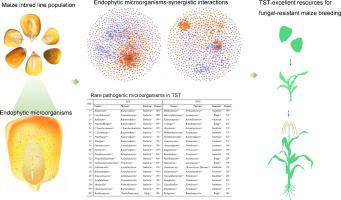当前位置:
X-MOL 学术
›
J. Adv. Res.
›
论文详情
Our official English website, www.x-mol.net, welcomes your feedback! (Note: you will need to create a separate account there.)
Insight into the composition and differentiation of endophytic microbial communities in kernels via 368 maize transcriptomes
Journal of Advanced Research ( IF 11.4 ) Pub Date : 2024-05-19 , DOI: 10.1016/j.jare.2024.05.018 Fang Tao 1 , Feng Chen 1 , Haida Liu 1 , Cheng Chen 1 , Beijiu Cheng 2 , Guomin Han 2
Journal of Advanced Research ( IF 11.4 ) Pub Date : 2024-05-19 , DOI: 10.1016/j.jare.2024.05.018 Fang Tao 1 , Feng Chen 1 , Haida Liu 1 , Cheng Chen 1 , Beijiu Cheng 2 , Guomin Han 2
Affiliation

|
Kernels are important reproductive organs in maize, yet there is a lack of systematic investigation on the differences in the composition of endophytic microorganisms in plants from a population perspective. We aimed to elucidate the composition of endophytic microorganisms in developing maize kernels, emphasizing differences among various inbred lines. The transcriptomic data of 368 maize inbred lines were used to explore the composition and diversity of endophytic microorganisms. The findings revealed a higher abundance of fungi than bacteria in developing maize kernels, followed by protozoa, while viruses were less abundant. There were significant differences in the composition and relative abundance of endophytic microorganisms among different maize lines. Diversity analysis revealed overall similarity in the community composition structure between tropical/subtropical (TST) and temperate (NSS) maize germplasm with apparent variations in community richness and abundance. The endophytic microorganisms network in the kernels from TST genotypes exhibited higher connectivity and stability compared to NSS kernels. Bacteria dominated the highly connected species in the networks, and different core species showed microbial phylum specificity. Some low-abundance species acted as core species, contributing to network stability. Beneficial bacteria were predominant in the core species of networks in TST kernels, while pathogenic bacteria were more abundant in the core species of networks in NSS kernels. Tropical maize germplasm may have advantages in resisting the invasion of pathogenic microorganisms, providing excellent genetic resources for disease-resistant breeding.
中文翻译:

通过 368 个玉米转录组深入了解籽粒内生微生物群落的组成和分化
籽粒是玉米重要的生殖器官,但目前缺乏从种群角度对植物内生微生物组成差异进行系统研究。我们的目的是阐明玉米籽粒发育过程中内生微生物的组成,强调各种自交系之间的差异。利用368个玉米自交系的转录组数据探讨内生微生物的组成和多样性。研究结果显示,在发育中的玉米粒中,真菌的丰度高于细菌,其次是原生动物,而病毒的丰度则较低。不同玉米品系内生微生物的组成和相对丰度存在显着差异。多样性分析揭示了热带/亚热带(TST)和温带(NSS)玉米种质的群落组成结构总体相似,但群落丰富度和丰度存在明显差异。与 NSS 籽粒相比,TST 基因型籽粒中的内生微生物网络表现出更高的连接性和稳定性。细菌在网络中高度连接的物种中占主导地位,不同的核心物种表现出微生物门的特异性。一些低丰度物种作为核心物种,有助于网络稳定。 TST籽粒网络核心菌种中有益菌占主导地位,而NSS籽粒网络核心菌种中病原菌含量较多。热带玉米种质可能具有抵抗病原微生物入侵的优势,为抗病育种提供优良的遗传资源。
更新日期:2024-05-19
中文翻译:

通过 368 个玉米转录组深入了解籽粒内生微生物群落的组成和分化
籽粒是玉米重要的生殖器官,但目前缺乏从种群角度对植物内生微生物组成差异进行系统研究。我们的目的是阐明玉米籽粒发育过程中内生微生物的组成,强调各种自交系之间的差异。利用368个玉米自交系的转录组数据探讨内生微生物的组成和多样性。研究结果显示,在发育中的玉米粒中,真菌的丰度高于细菌,其次是原生动物,而病毒的丰度则较低。不同玉米品系内生微生物的组成和相对丰度存在显着差异。多样性分析揭示了热带/亚热带(TST)和温带(NSS)玉米种质的群落组成结构总体相似,但群落丰富度和丰度存在明显差异。与 NSS 籽粒相比,TST 基因型籽粒中的内生微生物网络表现出更高的连接性和稳定性。细菌在网络中高度连接的物种中占主导地位,不同的核心物种表现出微生物门的特异性。一些低丰度物种作为核心物种,有助于网络稳定。 TST籽粒网络核心菌种中有益菌占主导地位,而NSS籽粒网络核心菌种中病原菌含量较多。热带玉米种质可能具有抵抗病原微生物入侵的优势,为抗病育种提供优良的遗传资源。
















































 京公网安备 11010802027423号
京公网安备 11010802027423号